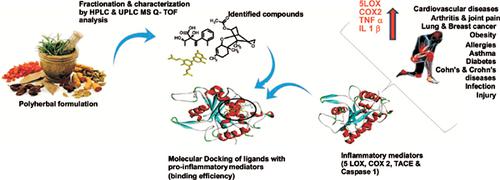Current Computer-Aided Drug Design ( IF 1.5 ) Pub Date : 2020-07-31 , DOI: 10.2174/1573409915666191015113753 Rahitha Devi S J 1 , Prakash Kumar B 1

|
Background: Balaguluchyadi kashayam, a polyherbal Ayurvedic decoction prepared from Sidacordifolia L., Tinospora cordifolia (Willd.) Miers, and Cedrusdeodara (Roxb. ex D.Don) G.Don, is used in Ayurveda for the treatment of chronic inflammatory conditions. Although this herbal decoction has been used for a long period for treating chronic inflammatory conditions, the mechanism of action of the decoction in reducing inflammatory conditions associated with chronic inflammation has not been clearly understood. Mass spectroscopy-based identification of bioactive molecules present in the decoction and its interaction with enzymes/proteins involved in the pathogenesis of chronic inflammation has been carried and reported in this study.
Introduction: Polyherbalism is one of the major principles of Ayurveda. Various phytoconstituents with different activities in the polyherbal decoction act on multi targets of a wide range of diseases. Balaguluchyadi kashayam is a polyherbal decoction prescribed for chronic inflammatory etiologies and the present study aims to evaluate the binding potential of the compounds, identified from Balaguluchyadi kashayam to enzymes/proteins involved in the development and progression of chronic inflammation.
Methods: The bioactive compounds present in the Balaguluchyadi Kashayam fractions were extracted by preparative HPLC and identified using UPLC MS Q-TOF. The physicochemical characteristics and ADMET properties of the compounds were calculated using Mol soft, Swiss ADME and OSIRIS data warrior software. Then the binding interactions between the molecules and the proinflammatory mediators such as 5 Lipoxygenase, Cyclooxygenase 2, Tumor necrosis factoralpha convertase enzyme (TACE) and Caspase 1 were determined using molecular docking software Auto Dock 4.0 (http://autodock.scripps.edu/downloads).
Results: The identified bioactive molecules in the decoction showed a good binding affinity towards the enzymes/proteins involved in the development and progression of chronic inflammation compared to the binding affinity of known inhibitors/drugs to the respective enzymes/proteins.
Conclusion: The bioactive molecules identified in Balaguluchyadi Kashayam could be developed as potential therapeutic molecules against enzymes/proteins involved in the development and progression of chronic inflammation.
中文翻译:

在计算机筛查中,从印度草药(Balaguluchyadi kashayam)的阿育吠陀汤中提取抗炎生物活性分子。
背景:Balaguluchyadi kashayam是由Sidacordifolia L.,Tinospora cordifolia(Willd.Miers)和Cedrusdeodara(Roxb.ex D.Don)G.Don制备的多草药阿育吠陀汤,用于阿育吠陀治疗慢性炎症。尽管这种草药汤剂已被长期用于治疗慢性炎症,但是该汤剂在减轻与慢性炎症有关的炎症中的作用机理还不清楚。这项研究中已经进行了基于质谱的生物活性分子鉴定及其与慢性炎症发病机制中涉及的酶/蛋白质相互作用的鉴定。
简介:多草药主义是阿育吠陀的主要原则之一。在多草药汤中具有不同活性的各种植物成分对多种疾病的多个靶标起作用。Balaguluchyadi kashayam是针对慢性炎症病因开出的多草药汤剂,本研究旨在评估从Balaguluchyadi kashayam中鉴定出的化合物与参与慢性炎症发展和进展的酶/蛋白的结合潜力。
方法:通过制备型HPLC提取Balaguluchyadi Kashayam馏分中存在的生物活性化合物,并使用UPLC MS Q-TOF进行鉴定。使用Mol soft,Swiss ADME和OSIRIS数据战士软件计算化合物的理化特性和ADMET性质。然后,使用分子对接软件Auto Dock 4.0(http://autodock.scripps.edu/下载)。
结果:与已知抑制剂/药物对相应酶/蛋白质的结合亲和力相比,该煎剂中鉴定出的生物活性分子对与慢性炎症的发生和发展有关的酶/蛋白质具有良好的结合亲和力。
结论:在Balaguluchyadi Kashayam中鉴定出的生物活性分子可作为对抗慢性炎症的发生和发展的酶/蛋白质的潜在治疗分子。











































 京公网安备 11010802027423号
京公网安备 11010802027423号